Please read carefully the Instructions for the "Web Accessibility for Older Users" Presentation at <http://www.w3.org/WAI/presentations/ageing/> for an introduction, tips, and permission to use.
The Notes section for each slide contains important information. Make sure you can read the Notes. On this slide, the notes start with "[NOTES SECTION: This is where the important information is . . .]"
Copyright © 1994-2010 W3C® (MIT, ERCIM, Keio), All Rights Reserved.
 This work is published and licensed under a Creative Commons Attribution 3.0 Unported License.
This work is published and licensed under a Creative Commons Attribution 3.0 Unported License.
For attribution requirements, see the "Creative Commons License (CC)" section of Using WAI Material.
[NOTES SECTION This is where the important information is: for each slide.]
This material is also available in other presentation formats from http://www.w3.org/WAI/presentations/ageing/
Note to presenters:
*DRAFT* Last Updated 22 September 2010
Welcome!
[Please leave this here in case the first slide gets deleted:
Please read carefully the Instructions for the "Web Accessibility for Older Users" Presentation at <http://www.w3.org/WAI/presentations/ageing/>]
Note to presenters: remember that some people may not be able to see the slides, for example, people who are blind or people listening to an audio-only recording of the presentation. Make sure that you say all of the information that is on each slide. See Advice for Presenters at <http://www.w3.org/WAI/presentations/#presenters>
Today I'll be talking about web accessibility and older people, based on findings provided by the W3C WAI-AGE Project (IST 035015).
The presentation will introduce the WAI-AGE Project; highlight the changing world wide demographic situation; discuss the prevalence and impact of age-related limitations and older people's use of the Web; introduce some of the findings from a literature review; highlight some of the requirements of older users and the role of WAI accessibility guidelines in meeting these; and talk about the current activities and outcomes of the WAI-AGE Project.
European Commission (EC) funded project focused on:
The Web Accessibility Initiative: Ageing Education and Harmonisation (WAI-AGE) Project is funded as a European Commission IST Specific Support Action with the goal of increasing accessibility of the web for older people as well as for people with disabilities in European Union Member States.
The WAI-AGE project is being undertaken by the W3C Web Accessibility Initiative (WAI) and is specifically intended to:
More information is available from the WAI-AGE project page
To better understand the context of the WAI-AGE Project, let's first look at the World Wide Web Consortium -- W3C, and the W3C Web Accessibility Initiative -- WAI.
Leading the Web to Its Full Potential:
The World Wide Web Consortium (W3C) is an international consortium where organizations located all over the world, and involved in many different fields, join W3C to participate in a vendor-neutral forum for the creation of web standards. Member organizations include technology companies, telecommunications companies, universities, government departments, and user organizations. Member organizations, a full-time staff, and the public, work together to develop open and royalty free standards for the Web.
W3C's mission is to lead the World Wide Web to its full potential by developing protocols and guidelines that ensure long-term growth for the Web.
This is about ensuring that the evolution of the Web is for everyone, everywhere, on everything. W3C operates from Massachusetts Institute of Technology (MIT) in the US, the European Research Consortium for Informatics and Mathematics (ERCIM) in France, and Keio University in Japan.
Key web technologies developed are through a multi-stakeholder and consensus-oriented process. These technologies include HTML, CSS, XML, SVG, SMIL, and many more that are used by developers to create websites and web software.
W3C also engages in education and outreach and serves as an open forum for discussion about the Web. In order for the Web to reach its full potential, the most fundamental web technologies must be compatible with one another and allow any hardware and software used to access the Web to work together.
Note to presenters: information about the W3C is available for more background.
Works to help make the Web accessible to people with disabilities through:
Within the W3C, the Web Accessibility Initiative (WAI) operates fully under the W3C process and pursues accessibility of the Web for people with disabilities through five primary activities:
People with disabilities include older people who experience age related functional changes and are rapidly increasing as a proportion of the population in most countries as the following slides indicate.
Note to presenters: information about WAI is available for more background.
As many may know, in most regions of the world we are observing a significant growth in average age. Let's look at some of the forecast demographic changes ...
Note to presenters: the following slides provide international and European statistics on the demographic changes. Some additional country-specific slides are provided in the Appendix for your selection. Depending on your audience you may want to add 1-2 of these slides into your presentation to localize it to your specific audience.
The point to emphasize is that the population is getting older in most regions of the world.
United Nations global demographic forecast
| Year | 65+ years | 80+ years |
|---|---|---|
| 2010 | 7.6% | 1.5% |
| 2020 | 9.3% | 1.9% |
| 2030 | 11.7% | 2.3% |
| 2040 | 14.2% | 3.3% |
| 2050 | 16.2% | 4.3% |
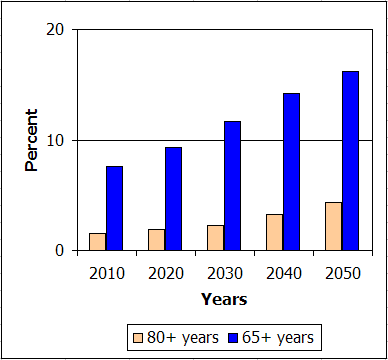
Source: UN World Population Prospects
The UN estimates that the global population of 65 years will grow from 7.6% in 2010 to 11.7% in 2020 to 16.2% in 2050 with the population over 80 years also increasing - from just 1.5% in 2010 to 4.3% in 2050. Europe today has one of the the oldest populations in the world, and is expected to continue to experience growth in its older population as we will see in the next slide.
References:
Note to presenters: remember that you may replace this slide or add country-specific slides provided in the Appendix section as needed.
Demographic forecast for the EU
| Year | 65+ years | 80+ years |
|---|---|---|
| 2010 | 17% | 5% |
| 2020 | 20% | 6% |
| 2030 | 24% | 7% |
| 2040 | 27% | 9% |
| 2050 | 29% | 12% |
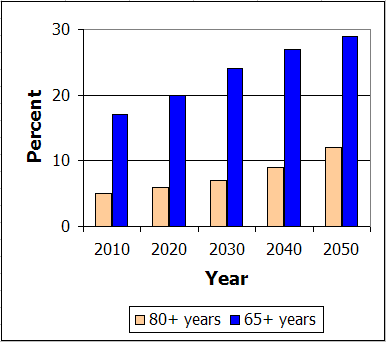
Source: EuroStat (PDF)
In the European Union, the EU-27 group of countries are predicted to to have nearly 30% of their population over 65 years by 2050, up from 17% in 2010 to 20% in 2020, 24% in 2030, and 27% in 2040. The proportion over 50, many of whom are still in employment, is forecast to increase from 36% in 2010 to 47% in 2050 and the proportion of older-old (those over 80) will also increase - from 5% in 2010 to 12% in 2050.
These forecast changes over the next few decades highlights the significance of this older group and emphasizes the need to provide support for older people:
An accessible Web contributes to the equal participation of all users, regardless of age or ability.
References:
Definition:
"EU-27" represents the 27 countries that comprised the EU as at 1 January 2007.
Note to presenters: remember that you may replace this slide or add country-specific slides provided in the Appendix section as needed.
With increasing age people often experience changing abilities - the next few slides look at the impact and prevalence of age-related impairments that affect web use.
Note to presenters: while these following slides present four different types of disabilities (ordered by their moderate/sever prevalence for older people) it should be noted that this is not an exclusive list and that people can experience other impairments including combinations of impairments.
Impact:
Prevalence:
Hearing starts to decline at around 50 years and affects a person's ability to hear higher pitched sounds as well as discern the foreground from background audio such as music or other sounds.
Some hearing loss is experienced by 47% of people 61 to 80 years and 93% of people over 81 years.
Moderate or severe hearing loss or profound deafness is experienced by 20% of people aged 61 - 80 and 75% of people over 80.
References:
Note to presenters: additional background on ageing and hearing loss is provided in Web Accessibility for Older Users: A Literature Review.
Impact:
Prevalence of significant vision loss:
Vision decline includes:
Vision decline often starts in a person's mid-40s with 86% of Australians over 40 requiring reading glasses to correct for near vision. Significant vision loss (that can't be corrected) affecting everyday life is estimated to affect 16% of people 65 to 74 years, and 46% of those over 85 years in the UK.
References:
Definitions:
Note to presenters: additional background on ageing and vision decline is provided in Web Accessibility for Older Users: A Literature Review.
Impact:
Motor skill decline can result from many conditions including arthritis, essential tremor, and Parkinson's Disease:
Prevalence:
(Conditions most commonly reported)
Motor skill decline impacts on dexterity and can result from many conditions, for example arthritis with associated joint stiffening and reduced fine motor control, and essential tremor or Parkinson's Disease with associated hand trembling, making mouse use difficult or impossible for some and also affecting keyboard use. In particular, older people with physical impairments may have difficulty clicking small links, selecting radio buttons, and using many fly-out or pull-down menus.
Arthritis is estimated to affect at least 50% of people over 65; essential tremor (one of many forms of tremor) is estimated to affect up to 5% of those over 40 and up to 20% of people over 65; and Parkinson's affects around 4% of those over 85.
References:
Note to presenters: additional background on ageing and physical decline is provided in Web Accessibility for Older Users: A Literature Review.
Impact:
Navigation, comprehension, and task completion can be affected by:
Prevalence:
(Conditions most commonly reported)
Cognitive decline is also common, though only dementia and mild cognitive impairment are commonly reported. While Dementia (including Alzheimer's disease) is experienced by some older people (1.4% of people 65-69 years increasing to 24% of people over 85 years in the UK), forms of mild cognitive impairment (or MCI) are much more common, affecting over 20% of those over 70 years. MCI can result in:
References:
Note to presenters: additional background on ageing and cognitive decline is provided in Web Accessibility for Older Users: A Literature Review.
Alzheimer's disease is the most common form of dementia accounting for between 50% and 70% of all dementia's (Alzheimer's Australia)
The Web provides older people with unprecedented opportunities for:
With the proportion of older people growing rapidly, the Web is increasingly important to enable older people to remain active and to participate equally. In particular, the Web enables older people to:
Additional resources about older people online include:
Older people are experiencing web accessibility barriers due to:
Web accessibility is an imperative.
The demographic forecasts and the age-related impairment statistics show an increasingly older population. As seen, many of these older people are likely to experience impairments, sometimes multiple impairments, that will impact on their web use.
In the next sections we will see that older people are experiencing barriers preventing them from accessing the Web due to:
Result: Web accessibility is an imperative in our information society, to overcome these barriers and ensure equal access for all citizens.
Note to Presenters: older people are increasingly online, for example:
Let's see what a literature review carried out by the WAI-AGE Project identified about the accessibility needs for older web users ...
WAI-AGE literature review included material about:
See "http://www.w3.org/WAI/intro/wai-age-literature.php" for details.
To better understand the accessibility needs of older web users, the WAI-AGE Project undertook an extensive literature review. This review included over 150 resources including scientific papers and popular articles. The range of literature reviewed included those that discussed:
Throughout all this literature was the strong sense that older people were enthusiastic about being online, though some didn't see the benefit before being online. There are now lots of "success stories" about older people using social networks, interacting with society via blogs etc, shopping and banking online, and much more, in addition to the majority who just use it regularly like younger people do.
WAI-AGE analysis showed a significant overlap with W3C/WAI recommendations.
It was also observed that:
In reviewing the literature and analyzing the findings and recommendations, WAI-AGE Project found a large overlap between the identified needs of older users and the WAI recommendations, particularly WCAG 2.0. However, it was also observed that:
Definition:
"older old" are considered as the group of people over 80 years (or sometimes over 85).
Note to presenters: inexperience is likely to diminish as a factor, but the question if older people adapt to the ever evolving web as quickly as their younger peers do remains a point for discussion.
Additional observations include:
WAI-AGE Project made some other observations from the literature review:
All these observations have implications for ongoing work and also suggest some research needed to fill gaps in our understanding and knowledge.
The implications of the analysis and observations are discussed in the following slides ...
Let's look at what role the WAI guidelines play in meeting the web accessibility needs of older people ...
W3C/WAI guidelines ensure access for older web users
Web accessibility depends on several components working together:
These accessibility requirements are also applicable to the accessibility needs of users with ageing-related impairments as the the following slides will describe ...
References:
Definitions:
Requirements include:
WAI's Web Content Accessibility Guidelines (WCAG) 2.0 addresses these requirements.
WAI-AGE Project found that many of the suggested requirements for making websites accessible to people with disabilities match the requirements of older users:
WAI's Web Content Accessibility Guidelines (WCAG) 2.0 addresses these requirements.
See WAI Guidelines and Older Web Users: Findings from a Literature Review for details on how WCAG 2.0 covers the needs of older users.
Usability improvements especially help older people and people with disabilities:
WCAG 2.0 also addresses these areas
Usability improvements that particularly help older web users also help people with disabilities:
These usability aspects benefit many other users too and are also included in WCAG 2.0, sometimes as advisory techniques to help optimize web content to specific user groups.
References:
Browsers are the entry-point to the Web:
WAI's User Agent Accessibility Guidelines (UAAG) helps address these issues.
Browsers play the key role in accessing the Web - they are the entry point.
However, many older people, and especially the older-old (over 85 years), are often new to computers and the Web - facing a steep learning curve. While this situation will decline as more older people come online and gain experience, it is still a contributing factor at present. Some studies of training older people in web use found that a simplified browser interface aided learning and understanding, though some wanted a browser with additional features as their familiarity and experience grew.
The low numbers of studies discussing adaptive strategies like changing text size or color schemes suggests that browsers could make these adaptations more obvious and available to users. Trainers and supporters of older people online need more information about how to adapt the user agent, or even the operating system, to adjust the interface for the age-related impairments that may be being experienced. Some browsers do not even work with some assistive technologies, reducing users' choice.
WAI's User Agent Accessibility Guidelines (UAAG) explains how developers can provide browsers and media players that support accessibility and can interact with assistive technologies. This includes improvements that can help simplify the learning process and improve the web experience.
Note to Presenters: more information on WAI guidelines:
Older people contribute to the Web:
WAI's Authoring Tool Guidelines (ATAG) help address these issues.
The Web is also about contributing as well receiving information - being an "author" as well as a "user".
Many people who are still in the workforce experience age-related impairments. These people may be required to contribute to their employer's website and intranet. Hence, the content management systems (CMS) and authoring tools used within an organization need to be accessible themselves and need to create content that is accessible for others.
User-generated content via wikis, blogs, reviews, etc is rapidly increasing. Older users are increasingly using online office-style applications, social networking, and photo sharing applications. Older people with impairments have many of the same problems as people with disabilities in accessing some of these newer web developments because they are not developed to be accessible.
Older people are also involved in developing and maintaining websites - either professionally or for leisure and personal use.
Note to Presenters: more information on WAI guidelines:
Let's now consider what the WAI-AGE Project will achieve and how you can help ...
As we have seen, older people benefit equally from web accessibility features. There is an on-going need to raise awareness of accessible web solutions for older people and people with disabilities. This includes accessibility features in websites and web software that enable older people to take full advantage of the opportunities provided by the Web.
We have also seen that WAI guidelines are essential for providing an accessible Web for older people as well as for people with disabilities. WAI-AGE Project is revising existing educational resources and developing new ones, to better explain how the WAI guidelines address the needs of older users with age-related impairments. These resources are targeted towards developers to inform them on the need of addressing the accessibility requirements for older people and people with disabilities, and towards end-users to inform them on how they can make use of, and benefit from, these accessibility features.
One of the issues identified is the duplication of work in this area, and the potential for divergence. WAI-AGE has found that older people and people with disabilities have a lot of requirements in common and there is a need to encourage researchers, website developers, and the community to work more closely together in promoting an understanding around a unified set of accessibility standards, and to avoid potential fragmentation by creating competing accessibility standards.
However, to address the accessibility needs of older people it is essential to involve users throughout the standardization process, to ensure an understanding of the requirements and solutions. WAI-AGE is actively seeking opportunities for collaboration and exchange with older users and user organizations, to encourage the participation and representation of older peoples' need during the development of WAI standards and resources.
WAI-AGE is developing resources to inform developers:
The web industry -- both organizations with websites and applications, and web designers and developers -- requires information:
Considerations for older people as well as real end-users also need to be involved throughout entire design and development process to ensure that the web products and services meet their needs.
WAI-AGE Project is developing a range of materials to increase industry awareness and support industry implementation.
Note to presenters: the planned WAI-AGE work in this area is discussed in WAI-AGE Deliverables - industry.
WAI-AGE is developing resources for older users and user organizations:
An increased awareness of web accessibility is also required among older users themselves, people who are providing training and support, and the organizations that represent them. In particular there is a need to:
WAI-AGE Project is developing materials to support user awareness and facilitate the promotion of web accessibility to older users and older peoples' organizations.
Note to presenters: the planned WAI-AGE work in this area is discussed in WAI-AGE Deliverables - users.
WAI-AGE is revising existing WAI resources, including:
WAI-AGE is developing new WAI resources, including:
Several existing WAI documents will benefit from having the needs of older users more explicitly addressed. These include:
New resources are planned to build on the WAI-AGE findings and the benefits of WCAG 2.0. These include:
Note to presenters: these document revisions and developments are on-going, please check the latest status on the WAI-AGE Deliverables page before each presentation.
Working together to avoid fragmentation through:
The development of competing web accessibility standards for older people poses a source of standards fragmentation, and reduces the level of adoption and implementation of accessibility solutions. Also, the low level of participation by older users and organizations representing older users in standardization, including W3C/WAI work, poses another potential source of fragmentation. The document Why Standards Harmonization is Essential to Web Accessibility provides more information about the impact of fragmentation of accessibility standards on solutions for older people and people with disabilities.
WAI-AGE Project is actively seeking and inviting participation by older people, and organizations representing older people, in W3C/WAI work, to better understand and address the needs in WAI standards and resources. This is primarily carried out through on-going dialogue and coordination efforts with other standardization bodies and with user organizations, and through promoting an understanding for the accessibility needs of older people and people with disabilities in a variety standardization settings.
Some research gaps that need further investigation:
WAI-AGE Project identified some research gaps in the understanding of the requirements of older people using the Web including:
Note to presenters: additional background on these research gaps and opportunities is provided in Web Accessibility for Older Users: A Literature Review.
People are invited to participate by:
People can actively contribute by:
See Participating in WAI for WAI participation details.
Note to presenters: you can also help us improve this presentation by providing comments to public-comments-wai-age@w3.org (a publicly archived mailing list). Consider asking your audience for feedback too.
The WAI-AGE Project is supported by:

More information on web accessibility is provided on the WAI home page located at <http://www.w3.org/WAI/>.
The WAI-AGE project page is located at <http://www.w3.org/WAI/WAI-AGE/>.
The WAI-AGE Project is funded by the European Commission (EC) under the IST Sixth Framework Programme (FP6).
Material for this presentation is provided by WAI at <http://www.w3.org/WAI/presentations/ageing/>.
Note to presenters: please make sure to acknowledge the funding source of the project as well as the original source for this presentation, as indicated in the notes above. If you wish to acknowledge additional sources for your presentation, please make sure that they are clearly distinguished.
Additional material that can be used depending on the audience.
W3C and WAI
Demographics - you may like to select from among the following slides for your own country:
Note to presenters:
Usually you should keep the total demographics slides to 2 or 3 as a maximum. The main message is that population demographics are changing and the population is getting older (very quickly in some countries).
Forecasts for all EU countries are available from EUROPE IN FIGURES - Eurostat yearbook 2006-07 (Chapter 1 - Population) PDF
UN forecasts for most regions and countries are available from the UN's Population database
Country specific forecasts may be available from the national statistics organization or government department in your country
International vendor-neutral consortium developing key standards for the Web
Within the W3C, the Web Accessibility Initiative (WAI) works to help ensure the Web is accessible to people with disabilities through:
The World Wide Web Consortium (W3C) is an international consortium where organizations located all over the world, and involved in many different fields, join W3C to participate in a vendor-neutral forum for the creation of web standards. W3C's mission is to lead the World Wide Web to its full potential by developing protocols and guidelines that ensure long-term growth for the Web. Key web technologies developed are through a multi-stakeholder and consensus-oriented process. These technologies include HTML, CSS, XML, SVG, SMIL, and many more that are used by developers to create websites and web software.
Within the W3C, the Web Accessibility Initiative (WAI) operates fully under the W3C process and pursues accessibility of the Web for people with disabilities through five primary activities:
People with disabilities include older people who experience age related functional changes and are rapidly increasing as a proportion of the population in most countries as the following slides indicate.
Note to presenters: Information about the W3C and about WAI is available for additional background.
Demographic forecast for the UK
| Year | 65+ years | 80+ years |
|---|---|---|
| 2010 | 17% | 5% |
| 2020 | 19% | 6% |
| 2030 | 22% | 8% |
| 2041 | 24% | 9% |
| 2051 | 24% | 10% |
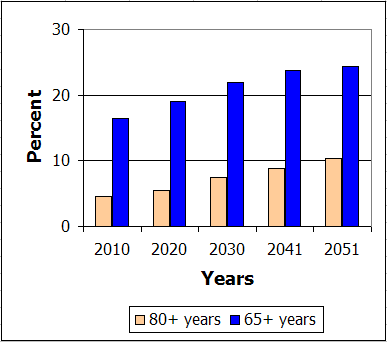
Source: UK Office of National Statistics
This slide shows the ageing trend in the UK ... the number of people over 65 years will rise from 17% in 2010 to 22% in 2030 to nearly 25% in 2050.
At the same time the proportion of 'older old' (over 85 years) is expected to increase from 4.5% in 2010 to 7.5% in 2030 and to just over 10% in 2050.
The proportion of people over 50 years is also growing - from 35% in 2010 to 39% in 2030 - and represents a significant number of people who may still be in the workforce and who may be starting to experience some age-related impairments such as vision and hearing decline (for instance the proportion of people with hearing loss increases sharply at around age 50, and 10% of UK blind and partially sighted people are in the 50-64 age group [76% are over 65 years]).
Demographic forecast for Spain
| Year | 65+ years |
|---|---|
| 2010 | 17% |
| 2020 | 20% |
| 2030 | 25% |
| 2040 | 31% |
| 2050 | 36% |

Source: Japanese Statistics Bureau
Source: EuroStat (PDF)
Spain is forecast to experience similar ageing patterns to the EU average for the next decade, but will exceed the EU average by the 2050.
[read out the data]]
Source: EUROPE IN FIGURES - Eurostat yearbook 2006-07 (Chapter 1 - Population) PDF
Demographic forecast for Japan
| Year | 65+ years |
|---|---|
| 2010 | 23% |
| 2020 | 29% |
| 2030 | 32% |
| 2040 | 37% |
| 2050 | 40% |
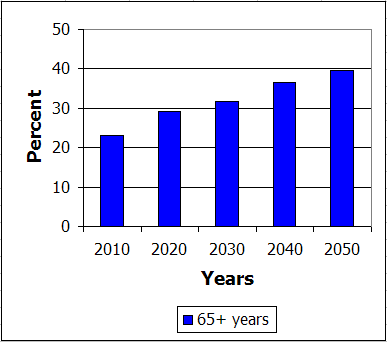
Source: Japanese Statistics Bureau
Discuss the numbers and emphasize that Japan currently has more than 1 in 5 people over 65 (23% forecast for 2010) ; within 20 years it will be 1 in 3 (32%) and rising to 40% by 2050
Japan's proportion of people over 65 years is the highest in the world, and the UN forecasts that the "population of Japan is projected to remain the oldest in the world with a median age of 55 years in 2050."
At the same time, Japan's total population is expected to decline from around 127m people at present to less than 90m people by 2050.
Demographic forecast for the USA
| Year | 65+ years | 85+ years |
|---|---|---|
| 2010 | 13% | 1.8% |
| 2020 | 16% | 1.8% |
| 2030 | 19% | 2.3% |
| 2040 | 20% | 3.5% |
| 2050 | 20% | 4.3% |
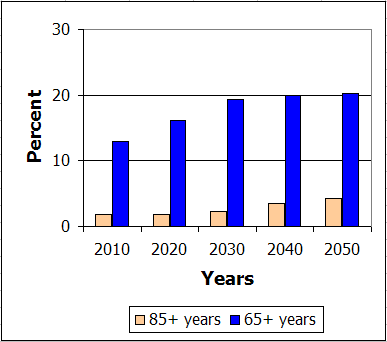
Source: US Census
The United States is forecast to experience lower ageing patterns compared with the EU. For example, the US is forecast to have 16% of its population over 65 year of age in 2020, while Europe forecasts 21%. In 2050 the US is only forecasting 20% of its population to be over 65 years compared with the European forecast of almost 30% over 65 years. A similar low trend in the population over 80 is also forecast for the USA with percentages about half those forecast in Europe.
[read out the data - at least the 65+ years]
Source: US Population Projections (released 2008) - see Table 3
Demographic forecast for Australia
| Year | 65+ years | 85+ years |
|---|---|---|
| 2009 | 14% | 1.8% |
| 2016 | 16% | 2.1% |
| 2026 | 19% | 2.4% |
| 2036 | 21% | 3.5% |
| 2046 | 22% | 4.4% |

Source: ABS Population Projections
Australian projections are ... [read out numbers]
Australia is forecast to experience lower ageing patterns compared with the EU average. For example, Australia is forecast to only have 19% of its population over 65 year of age in 2026, while Europe forecasts 36% in 2025.
Source: ABS Australian Population Projections (2006 TO 2101) - Catalogue # 3222.0